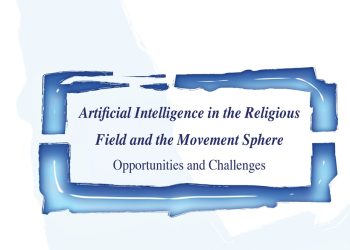The logic of storytelling in social context, not science, determines what people come to believe. That includes not only beliefs about God, but also about human nature, race, politics, and how they all mix together. Suffice it to say that what people believe, from the sublime to the preposterous, affects what people do.
My favorite cartoon strip is a Non Sequitur single-panel job from 1995 titled “Dogs’ Editing Process.” In the panel the artist, Wiley Miller, has his main character telling his dog as he’s about to leave the apartment: “I’m going out….Don’t get into the trash while I’m gone.” And the dog, sitting and listening carefully, is thinking via a dialogue cloud: “Go….get….in….the…trash…..while…gone.” It took me years to understand that the cartoon isn’t really or just about a person and a dog. It’s about people, particularly people from different cultures but also people with different perspectives inside a culture, understanding just enough about each other to get the basics totally wrong, without, of course, realizing it until too late.
The same cautionary warning abides in one of the most famous lines of English poetry ever written–or, in this case, a Lowland Scottish variety of it. Thus Robert Burns, writing in 1786: “‘O, wad some Power the giftie gie us, To see ourselves as others see us! It wad frae monie a blunder free us, An’ foolish notion.” Standard English translation: “Oh would some power the gift to give us, to see ourselves as others see us! It would from many a blunder free us, and foolish notion.”
What if misapprehension is mutual and simultaneous? Literature has an instructive tale to tell about that, too: The American writer O’Henry’s famous early 20th century tale “The Gift of the Magi.” In the story, two young lovers want to buy holiday gifts for one another but both lack funds. So the young man sells his precious watch to buy combs and ribbons for his love’s beautiful long hair; meanwhile, she sells her beautiful locks to a wigmaker to buy a chain for her lover’s treasured watch. When they open their gifts together, their surprise soon gives way to the realization that they have proven their true love for one another, for each has given up something important for the sake of the other. The mishap is only temporary, anyway: Her hair will eventually grow back and he will at some point be able to afford a new watch, so the gifts are not in vain.
Alas, stereoscopic misapprehensions, or merely a nexus of good intentions that doesn’t produce expected outcomes, do not always end so happily. Sometimes they clot up sociologically and create an enormous weight of ill will, untoward behavior and even murderous tragedy. The point of using literature to enter this fraught subject is two-fold. First is to show that fiction is not mere entertainment, but is rather the portal to critical insights about human social nature that more didactic, cold-blooded writing is powerless to capture. Second is to highlight the power of stories and storytelling–in other words, of narratives in all human relationships, including political ones.
Franz Kafka once said God created humankind to tell stories. Whether He did or not, narratives shape our interpretations of events, intentions and how they blend together. That is because every story, every narrative, moves along according to a logic of one sort or another; if the actions described are random, one does not a story have. When people use stories to explain or persuade, the logical framework chosen determines the way the stories comes across and affect others. If the listener follows and accepts the logic as valid, whether he consciously realizes he is evaluating the plausibility of the story or not (usually not in normal life), he is more likely to be influenced by the story, all else equal.
All else is not equal, however, and the most important factor weighing in on whether stories take hold is their social context. If many other people the listener respects or cares about believe the narrative, then pressure mounts on a given individual to believe it, too–and if not, then not. This applies to narratives written down as well as communicated orally. Famous experiments on conformity designed by Solomon Asch back in the 1950s showed that people can be induced to believe some very questionable statements solely through the workings of peer pressure. At the extreme, all cults, political and religious, create coherence and high morale by generating common belief in very improbable tales of origin and causation.
Why is this important? Because the social context in which stories are created, communicated, and either accepted or not are critical in shaping relationships among groups within national borders and between them. In short, they affect both domestic and international politics. They do so through what are typically called stereotypical images.
A stereotype is an extreme simplification, via some narrative or storyline, of group characteristics. There is always a seed of truth in a stereotype but there is also always massive distortion via oversimplification. Sometimes the distortions are positive in valance, but more often they follow an in-group/out-group distinction and tend to be negative. The points here are that: stereotypes do not exist outside of storylines; and stereotypes usually include condensation symbols, powerful nuggets of emotive language, that encapsulate that storyline. In negative in-group/out-group dynamics these condensation symbols are often epithets, or slurs about ethno-racial characteristics.
Stereotypes are part of a dynamic that has literal life-and-death implications. Many examples of different kinds could be described. We could look at one fairly anodyne example concerning the arts of political speechwriting, using the tone-deafness of the new Biden Administration as an example. Or we could discuss the nexus between contemporary race relations in the United States and the burgeoning of lurid conspiracy theories about that and other matters. In the interest of time and mercy upon you, dear reader, we limit ourselves here to the latter topic.
Despite a long and sordid past and plenty of unfinished business, the contemporary United States is the best example in history of a successful mass multiracial and multiethnic society. That may not say much about humanity, but it is true all the same, and it is true despite the current, and recurrent, highly ideologized moral panic about race in the United States.
We Americans are egalitarian-minded despite our not always acting as our collective mind would have us act, but for that reason we are impatient with imperfection. Because we are imperfect every generation, it seems, has to rediscover what we fail but need to do–but without disparaging what we have done right or minimizing hard-earned achievements. That trick is now getting harder to pull off. The leftwing, neo-Marxian argument, still a minority argument but one gaining ground since the “George Floyd” incident of May 25, that America is foundationally and systemically racist is false. As Ayaan Hirsi Ali put it correctly and plainly in the June 26 Wall Street Journal, “America is the best place on the planet to be black, female, gay, trans or what have you. We have our problems and we need to address those. But our society and our systems are far from racist.” But her argument, even coming from a black woman speaking truth to powerful nonsense, is implausible to many today for two main reasons.
The first is that the fact of enduring structural racism, most evident in educational, housing, and job discrimination against African Americans, is undeniable. The conflation of the two is inevitable when placed in an ideological as opposed to an analytical framework or storyline because ideology, whatever else it is, is premature synthesis. It leaps to emotional conclusions beyond the evidence. It is like a half brick: not as useful as a whole brick if you want to build something, but it can be thrown roughly twice as far if you want to harm someone or break something.
The second reason cannot be disentangled from the first. The foundational racism argument is more plausible lately because there is now in the United States, more overtly than at any time for a century past, what it is fair to call a racist major political party: the Republican Party as currently constituted in the image of former President Donald J. Trump. The Republicans, and Trump in particular, have sought to “dogwhistle” racism to divide Americans and then harvest the resulting anxieties. They use euphemisms like “law and order” to communicate to constituencies listening for out-of-normal-range signals rather than appeal directly to racist sentiment as used to be the case seventy years ago.
Indeed, because of exaggerated demographic paranoia, many Republicans, faced with a choice in their minds between keeping America culturally and politically “white” and respecting the democratic will of the electorate, have chosen the former. They want, in effect, to substitute a “dirty white” shade of ethno-nationalism for the civic nationalism that has always been at the heart of American political culture. Otherwise they would not be engaged in voter suppression efforts in recent years and some highly placed Republicans would not have tried early last month to stage a coup based on a Big Lie about a stolen election, while most other Republicans looked the other way and then made excuses for it based on a whole raft of smaller lies.
This is not, of course, an entirely new phenomenon. In the autumn of 1957 President Dwight Eisenhower federalized the Arkansas National Guard and ordered it to enforce public school desegregation in Little Rock. He knew the law of the land since the 1954 Supreme Court decision in Brown v Board of Education: the “separate but equal” doctrine enshrined in law in Plessy v Ferguson (1896), and that was part and parcel of the post-Reconstruction Jim Crow reality in the American South, was pronounced unconstitutional. Eisenhower took seriously his oath of office to protect the Constitution, and so he acted. When he did, the Dixiecrat South reacted with fury.
The Democratic Party in 1957 was nearly as divided, largely over the question of race, as the Whig Party was in 1852 and as the Republican Party is today over the question of whether to be sane or crazy about race (and everything else). A major difference is that following World War II American politics were largely local: internally diverse national coalitions of Democrats and Republicans formed only every four years in advance of a presidential election. That is when differences over race tended to become most salient and sharpest.
Thus, in 1948 Democratic President Harry S. Truman unilaterally desegregated the U.S. armed forces. In that same year, a huge argument broke out during the Democratic National Convention over segregation. Senator, and later Vice-President, Hubert H. Humphrey of Minnesota led an effort to rid segregationists from the party and to reform voting rights protocols in the American South, which was solidly under Democratic Party control. The result was that South Carolina’s Strom Thurmond walked out of the convention and ran for President as an independent on an explicitly pro-segregation platform. He carried four Southern states, but Truman kept the presidency.
Those four states–South Carolina, Mississippi, Alabama, and Louisiana–were all basically one-party authoritarian racist mini-polities, and had been since the end of Reconstruction in 1876. Republicans didn’t stand a chance of getting elected anywhere in the former Confederacy; political action engaged different factions and personalities among Democrats, all of whom endorsed legal segregation. But when, after World War II, the Democrats tried to reform themselves internally, some Republicans saw an opportunity to expand their base. The first glint of that opportunity being operationalized politically on the national level took place in 1964, when the Republican candidate for President, Senator Barry Goldwater of Arizona, voted against the hallmark Civil Rights Act.
Four years later Richard Nixon launched his “law and order” Southern strategy, basically using dogwhistle racism, then about “busing” and affirmative action, to lure the electorates of the Southern states from the Democratic to the Republican side. He did so by taking advantage of heightened anxieties among white people over the urban race riots and violence of 1967 and especially 1968 after the April assassination of Martin Luther King, Jr. It worked: Nixon won election in a close race with Vice-President Hubert Humphrey, and the reason had far more to do with the crucible of American race relations than it did, as still commonly supposed, with disagreement over Vietnam War policy.
Perhaps the most important shift in American politics over the past 75 years has been this transformation of the American South from a Democratic to a Republican stronghold. The Democrats, not the party of Lincoln, used to be the party of American racism, at least in large part; it was certainly the party of the most avowed racist to occupy the Oval Office before Trump: Woodrow Wilson. The Democratic Party remained well into the 1950s the party of de facto authoritarian one-party rule in the states it controlled, states that had tolerated both lynching and the Ku Klux Klan and had not apologized for either. So powerful was this political force that not even Franklin Delano Roosevelt, as powerful as he was as a multi-term President, dared challenge it head on. Now the Republicans own that same problem.
I grew up in segregated Virginia in the 1950s. I was born before Brown v Board of Education, and I remember what segregation looked like very well, for it persisted more or less untouched for at least a half dozen years after that 1954 decision. I also remember how adults explained to me as I got older how the whole terrible, humiliating and tenacious system of routine bigotry worked on the level of daily life, and it is a lesson I have never forgotten.
It is a lesson which teaches that outright evil intentions are not usually what create morally depraved situations like segregation, or even, long before it, slavery. Evil results as much from ignorance, complacency, conformity, and laziness as it does from overtly demonic motives. It is true, alas, that some racists–white and black in the American context–can seem like and actually be “fine people” in many respects, entirely normal when they are not perseverating on race. (It is, of course, another thing altogether for an American President to say such a thing after a violent event in which some members of a mob rallied around a Nazi flag.) That said, what is the lesson I learned?
Imagine a situation where a high-rise low-income housing development is situated in an urban area, within walking distance of shopping districts and better, higher-tone real estate neighborhoods. An example of exactly that situation can be found in the Queens Village section of downtown Philadelphia. In a situation like that, African American youth are growing up more often than white and other kids in broken homes, and in subcultures that for historical reasons do not have parents or a parent who reads to them and is hardly ever seen reading a book. African American kids living in those “projects,” as they are called, are likely to come from homes with less disposable income and more stress about making ends meet, too.
They are also likely to experience a style of parenting that is qualitatively different from that of middle-class families, and that shows particularly in communication patterns. Middle-class parents, including parents in a steadily growing African American middle class, tend to address children of a certain age with complete grammatical sentences, and they often ask their children questions to train them for participating in normal adult relationships. Lower-class child-rearing, and this is true of most white lower-class families as well, tends to far more curt communication. Short, staccato commands from parent to child are more the norm: “Do x,” “don’t do y,” “eat your lunch,” “pick up your stuff,” and, above all, “be quiet.” The kids pick up from their parents’ tough-talk subtle and not-so-subtle cues that life is hard and unpredictable, anxiety is normal, and trust is rare outside the home. So the bottom line message is that kids need to learn to be tough enough to look after their own interests. Example: If Johnny from down the hall punches you, don’t go running to me or to your teacher to tattle; just punch him back, harder.
The result is that most African American kids in the Philadelphia projects, and of course similar home environments elsewhere, grow up less emotionally secure, less well-nourished in many cases, and less home-educated in basic skills before they go to schools that are often de facto segregated and thus normalize and reinforce the deficiencies already described. They tend to suffer from significant word poverty compared to middle-class kids before the first day of school; they do not enter a level playing field, but not just because of the deficiencies of the school system. The prior difficulty starts in most cases the day they are brought home from the hospital after birth.
So the poorer kids–and this is true in every culture–tend to develop tougher, zero-sum minded conceptions of life. And because of the sub-cultural lack of high valuation for “book-learning” education, they do less well academically, thus perpetuating the cycle of their sub-cultural inheritance. They often fail to become deep literate, and as a result tend to be more present-oriented. Present-orientation makes it harder to imagine concrete futures, harder to plan, harder to stay on task, harder to build self-discipline, harder to achieve reliable impulse control. A lot of employers are unenthusiastic about hiring such people.
As should be clear, these patterns are class-based, not race-based. They are cultural, not biological. But American history has sired a massive overlap between class and race. Stereotypes that arise from and apply properly to class thus often get transferred to race, especially when middle-class whites in urban areas see more lower-class African Americans than they do rural lower-class white people. (Race perceptions and relations between lower-class African Americans and whites is a highly variable and complicated story we’ll not get into here.)
So back to Queens Village and the development of stereotypes. A 14-year old African-American kid will want a bike, like every other kid. If his parents or parent can’t afford to buy one, a small percentage of especially male kids will go hunting in the wider neighborhood to “borrow” or outright steal one. Let’s stipulate for the purpose of this lesson that the percentage of African American male kids who become bike thieves is 3 percent. That means 97 percent are not bike thieves.
But to white folks in the area, just about all the bike thieves turn out to be African Americans–say 97 percent of them. So white people will tend to create a stereotype holding that black kids are thieves, and they’ll generalize from bikes to other items, and from other items to bikes. The human mind is, as we know, promiscuously associational. As a result, they will develop at best ambivalent attitudes toward African Americans, especially males, and some increasingly small percentage–thank God for that–depending on their own upbringing, will become racists.
Now, the non-thieving large majority of black kids will experience white attitudes as unfair and hostile, which they are. They will often develop reciprocal stereotypes in consequence. And then the stereotypes will bounce off and reinforce each other over years and even lifetimes and they will too often be passed down as an inheritance within families like bad genes. Everyone ignores Robert Burns. They don’t try to see life from the other person’s perspective. They’re terrible at intuitive math, so 2 percent or 5 percent might as well be 100 percent for all practical, deeply sad, purposes.
The parallel fears and neuroses that these stereotypical misperceptions generate are multiple, massive, and tenacious. It takes all our heart over many years to fight back against them and reduce them insofar as we can; but we do it, and we have been successful at it more often than not, at least until recently. But things can and do get worse sometimes when for reasons having nothing to do with race the society as a whole experiences significant depletions of social trust, becomes more group conscious and zero-sum mentality addled, and on top of it all has to deal with a monstrous pandemic that has killed half a million of us and otherwise literally driven large numbers of security-spoiled Americans crazy.
Racism both real and especially racism exaggerated, manipulated and instrumentalised is to some extent the engine inside the careening, out-of-control American car right now, and the wheels may be about to come off. Under current circumstances, social science facts don’t stand a chance against the sirens of moral panic and ideological exaggeration. This is ironic, of course, because if one soberly compares how racist (and misogynist and anti-Semitic) American society was before World War II–let’s pick 1941 as a convenient year–it is almost indescribably less so now, eighty years later. But for many people, and particularly for many Americans who know little history and could care less about it, this is not their view. The stories they hear and buy into tell another tale, and some of those stories have lately become utterly preposterous. And so to our final topic: the Jews, of course.
QAnon conspiracy theory is more than a bunch of disconnected irritable mental tics. It is not a garden-variety conspiracy theory about past and present, but a full-fledged myth that includes a narrative arc, spun by a charismatic prophet, that predicts a climax of violence, epiphany, and salvation in the future. Given its particular North American Protestant inheritance, and notwithstanding the anti-Semitism it shares in common with its European forebears, it comes across to non-believers as a bizarre combination of the Book of Revelations, the Rapture, and a combat-themed video game. It qualifies as preposterous in spades.
But it is also anti-Semitic, and it is rapidly spreading among Republicans, even now dominating state-level party cadres in Arizona, Wyoming, Hawaii, Oregon, Texas, and beyond. QAnon would not be complete without the claim, articulated by Georgia freshman Congresswomen Marjorie Taylor Greene, that the recent California wildfires were set deliberately by Jews shooting lasers from outer space.
QAnon fantasies parallel the infamous late-19th century Czarist forgery The Protocols of the Elders of Zion. In both there features a secret cabal of Jews scheming to control the world, now called “Globalists.” In both there features murdered children and macabre rituals: long ago the “blood libel” about Jews murdering Christian children to use their blood to make Passover matzah, now the adreonochome drug bloodlust, claiming inter alia that a dark web video exists of Hillary Clinton and Huma Abedin ripping the face off a dead child to drink its blood (no such video exists). The Jews/Globalists have untold money weaseled from common people–here is where George Soros comes in these days to replace the Rothschilds of old. They now control America’s “fake” lying media. They are embedded in the American “deep state.”
Only, as noted, QAnon has a special lunatic Protestant flavor: Its adherents believe that the real power behind today’s ruling American elite is none other than Satan, who is also the anti-Christ, archetypically the Jew. In the Rapture-addled world of the neo-evangelical, Jesus amounts to Santa Claus for physiological adults, and superhero narrative bad guys have so blurred with their image of Satan that you almost expect an animated Jesus to whip out a light saber to do battle with hook-nosed villains.
Lurid anti-Semitic fantasies, which also carry a footlocker full of stereotypes, are of course no newer than the ubiquitous racist tropes of the American political past. Here is now Norman Cohn described the basic phenomenon in 1966, referring of course to the Nazis in Germany and Europe; but it doesn’t strain the brain to see this description fitting QAnon adepts and helping to explain the events of January 6.
There exists a subterranean world where pathological fantasies disguised as ideas are churned out by crooks and half-educated fanatics for the benefit of the ignorant and superstitious. There are times when this underworld emerges from the depths and suddenly fascinates, captures, and dominates multitudes of usually sane and responsible people, who thereupon take leave of sanity and responsibility. And it occasionally happens that this underworld becomes a political power and changes the course of history.
This is not to say that America in 2021 is like Germany in 1933, or that QAnon types are Nazis, or that the catastrophic outcomes of the past will be replicated in the near future. But it does concentrate the mind.
Some think the current American madness is owed to the stresses of the pandemic, and that things–including the Republican Party–will return to normal once the viral cloud finally passes. Maybe, but that may end up changing less than many hope. Listen to Gustave Flaubert’s description of the aftermath of the Revolution of 1848 in Paris, which also involved the sacking of symbolically important buildings, in A Sentimental Education (1869):
For fear of an epidemic, a commission of enquiry had been set up. . . . The ones who’d taken no part in the actual fighting were particularly anxious to demonstrate their keenness; people were panic-stricken and blindly settling old scores against . . . everything that had been infuriating them for three months. . . .The public mind was disturbed, as though after some cataclysm. Some intelligent people remained fools for the rest of their lives as a result.
For now, at least, recent polls show that most Republicans have managed to absorb and even to embrace the January 6 attack on the Capitol. Some 58 percent of them blame congressional Democrats, along with Black Lives Matter and Antifa cadres, for the riot; only 27 percent blame Donald Trump. Trump is also the prohibitive favorite for the party’s 2024 presidential nomination, with 54 percent.
That means that the Capitol riot mob is for practical purposes the Republican Party now, as many former “normal” Republicans have left the party to be replaced and more by recently mobilized populists. (Something similar happened in 1896 when the recently arisen Populist Party took over the Democratic Party.) Thus, as things stand now, nearly 80 percent of Republicans approve of Trump’s job as President; 65 percent claim that there is “solid evidence” for Trump’s claim that the election was stolen even though no such evidence has surfaced, because it doesn’t exist. It may or may not be a party of Flaubert’s fools, but for the time being it certainly looks like a party of the delusional, the racist, and increasingly the anti-Semitic.
So how long will “the time being” last? No one knows. Hindsight is not 20/20, as the saying goes, or else doing archival history would be easy–and it’s not. But it seems to me that once the Republicans absorbed the Dixiecrat South through the Goldwater-Nixon “Southern strategy” in the 1964-72 period, the one-party racialised authoritarianism of that political subculture would eventually infect the Republican Party as a whole; and from a racialised authoritarianism it was only a matter of time before the party turned as well to anti-Semitism. They all do, it seems–even the Chinese Communist Party, which is accurately described as both racialist and authoritarian, is now hounding and pressuring the millennium-old Jewish Community of Kaifeng.
Most likely, then, the Republican Party will grow even crazier and more overtly racist and anti-Semitic than it is now, pandemic or no pandemic. Clearly, Trump and the current litter of Republican officeholders and consultants learned from Nixon’s example, and used both anti-black and a large dollop of anti-Hispanic and anti-immigrant dogwhistling to win in November 2016. Leveraging anxiety over the post-“Georg Floyd” violence they tried to do it again this past November. It proved unsuccessful this most recent time around, but had it not been for Trump’s mishandling of the pandemic, it would probably have worked again.
Beyond its fall into racism and anti-Semitic bigotry, we also see the transformation of the Republican Party into an authoritarian party in the fact that it tolerates no internal dissent. It also no longer even pretends to respect the traditional virtues of classical liberalism: humility, civility, tolerance, open debate in the search for truth, the acknowledgement of a “loyal” opposition, and devotion to the rule of law.
The real question, then, is this: Will the Republican Party marginalise itself into political oblivion as a result, or will it actually achieve power? If the latter, it can only do so by destroying American liberal democracy once and for all as it delivers the country into the torch-and-pitchfork-laden arms of a mass populist mob gone mad. No one knows the answer.
In any event, some interesting side questions for Jews and Muslims, in America and in the Middle East, arise out of all this. Let’s pose a few.
How can so many Orthodox Jews and ultra-nationalist rightwing secular Jews, in the United States and in Israel, justify their outright enthusiasm for Donald Trump in the face of the anti-Semitisation of the Republican Party? What can the Saudi and Emirati leaderships now say about their affection for Trump and his Retrumplicans?
Back to this side of the ocean, how can Republican anti-Semites simultaneously endorse Trump’s exaggerated claims to have fathered the Abraham Accords and not frown at the UAE’s sensible and courageous anti-anti-Semitism approach to normalization?
Are we headed back to a situation where the most crazed, radical and anti-Semitic rejectionists in the Arab and Muslim worlds will find an anti-Semitic Republican Party their natural ally, no less that Hajj Amin al-Husseini was attracted to Adolf Hitler and the Nazis in the 1930s?
Finally, how will the still endemic conspiratorial anti-Semitism in Arab and Muslim societies make sense of a populist anti-Semitic Republican Party in the United States? The answer is only too obvious: the same way that anti-Semites in the United States will make sense of it. They will simply identify the Democrats with Jews (and of course, Satanists) and claim that the Democratic Party is the cat’s paw of the Jewish conspiracy. It’s only a matter of time before someone claims that Hillary Clinton is secretly a Jew, and Huma Abedin too (why else would she, a supposed Muslim, have married a Jew?).
But this isn’t even necessary. Just look at the peopling of the new Biden Administration. The Vice-President’s husband is Jewish. The top three officials in the State Department are Jews: Anthony Blinken, Wendy Sherman, and Vitoria Nuland. The Secretary of the Department of Homeland Security, Alejandro Mayorkas, is a Jew. The soon-to-be Attorney General, Merrick Garland, is a Jew. Of course the Secretary of the Treasury, Janet Yellen, is a Jew. To exhaust the power ministries, Secretary of Defense Lloyd Austin is an African-American, true, and there is no evidence or suggestion that he is Jewish. But the nativist, reactionary minority of Americans who hate blacks also tend to hate Jews, so it may be a distinction without a difference. There’s not much for Arabs or Muslims to take heart in, however, for the nativist reactionaries hate them, too–they’re all terrorists, goes the stereotype, every one of them. The Biden Administration may be the easiest-to-hate administration in American history for bigots. What will they do with so much free fuel?
One of these days there will be literature–fiction, poetry, song, cartoon art even–that captures some of the mania on offer today, the violence, the racist abominations, the moral panics, the slouched lying, the heroism and hope too. Some of that literature may be expressed in Arabic and Hebrew as well as English. Lots of cultures, after all, have “dogs in the fights,” as we say in colloquial American, swirling around us these days.
Future generations will know something about how this feels through that literature, but what they come to know will depend on who tells the stories, how well and persuasively they tell them, and who is therefore believed. It’s a sure thing that scholarly work will never capture how this moment aches and shocks us. “A scurry of events gives flavour to a decade,” wrote the Australian historian Geoffrey Blainey in the mid-1990s. Well, we have had about all the flavour we can handle in less than half a decade–and scurrilous, indeed, most of it has been.
We, individually and especially collectively, are bound in time to forget the details; we always do. But the least we should try to do is to remember the tone of the times, so that we retain some idea of what we are forgetting. That is what literature can do, will do, for us and for our progeny. That, anyway, is my story.














